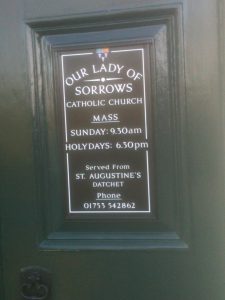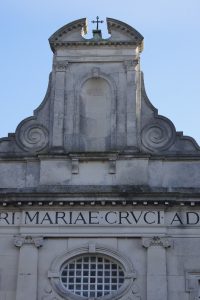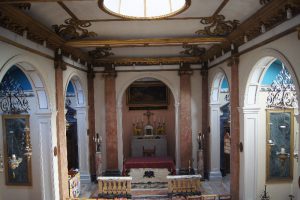Why the St. Nicholas Society?
Henry VI was born on the 6th December 1421 at Windsor Castle. As a very devout and religious Catholic he put great significance into the date of his birth – 6th December – which is the feast day of St. Nicholas. It is suggested that part of the impetus behind the founding of Eton College was his devotion to St. Nicholas who was celebrated as the patron-saint of children. This meant that as King he was desirous that his subjects – especially the young – should enjoy opportunities of acquiring knowledge.
History
Catholic interests at Eton had been represented from at least the 1950s by the Old Etonian Catholic Association, which held an annual dinner. As the number of boys at the school began to increase it was decided to form a society to represent their parents, who were concerned that the provision of specifically Catholic religious instruction for their sons was limited, and this society merged with the Old Etonian Catholic Association in the late 1960s.
The Society’s main achievement was to negotiate with the school for a resident Catholic chaplain. By the time the first chaplain, Father Peter Knott SJ, arrived in 1985 the number of Catholic boys in the school had grown to around 150 and it has continued to increase. Currently there are over 250 Catholics in the school.
The Society’s membership is open to the parents of Catholic boys at Eton, Catholic Old Etonians and others whom the Society wishes to elect. Its objects are: to advance religion at Eton and to ensure the provision of religious instruction in accordance with the teachings of the Catholic Church, subject to the general directions of the local bishop; to provide a Catholic priest and to maintain and assist him; and to encourage and support wherever possible the active participation of Catholic Etonians in charitable works, particularly those organized by the Society or by other Christian charitable bodies.
Our Lady of Sorrows

If only Alfred, the fifth Lord Braye were here to celebrate this very special occasion of the recent purchase by Eton College of Our Lady Of Sorrows, Eton’s original Roman Catholic Chapel. A place of worship known to many catholic OEs and now to many current Etonians once again. How the wheels have turned. The fascinating story behind the Chapel provides a snapshot of the changing times in inter-church relations in England.
It was Lord Braye’s wish that as a Roman Catholic and OE, the Chapel should be built to be used by the Roman Catholic students of Eton College and the parishioners of Eton and Datchet village. Around 1905, land was purchased by Lord Braye to build a “bungalow” just off Eton High St. The Chapel would be dedicated to Our Lady of Sorrows in reparation for the destruction of the Lady Altar in Eton College during the reign of Edward V1.
However when it became known that this “bungalow” was to become a Roman Catholic church, Eton College authorities wrote to Rt. Rev. William Keating, Bishop of Northampton, asking him to forbid Lord Braye proceeding. However Keating backed Lord Braye albeit reluctantly. He was not particularly happy with the idea of Roman Catholic boys going to Eton College in the first place. The local authorities invoked a number of building regulations to prevent Lord Braye’s chapel becoming too obvious. Windows were forbidden in the body of the church and water “running off the structures was not allowed to drain into any part of council land. Both issues were cleverly resolved by the construction of an effective roof skylight which also permits rain water to run into a tank over the sacristy and any overflow to run into an underfloor soak behind the High Altar.
 Today the rather drab and well disguised exterior of Our Lady of Sorrows conceals an embarrassment of riches. The Church and all its furnishings were paid for entirely by Lord Braye who wanted to recapture in Our Lady of Sorrows the essence of a small Italian church of the 18th century. The Venetian influence is evident in the elaborate craftsmanship of the domes and the fourteen different types of Carrara marble used to adorn the high altar and six side altars, some with insets of malachite and lapis lazuli. The paintings are copies of well known works of art, including a Madonna from the School of Raphael.
Today the rather drab and well disguised exterior of Our Lady of Sorrows conceals an embarrassment of riches. The Church and all its furnishings were paid for entirely by Lord Braye who wanted to recapture in Our Lady of Sorrows the essence of a small Italian church of the 18th century. The Venetian influence is evident in the elaborate craftsmanship of the domes and the fourteen different types of Carrara marble used to adorn the high altar and six side altars, some with insets of malachite and lapis lazuli. The paintings are copies of well known works of art, including a Madonna from the School of Raphael.
Our Lady of Sorrows was dedicated on 20th January 1915. However, the College at first forbade students attending Mass there until 1920 when tensions had eased and the boys were allowed to attend Sunday Mass and then return that same evening for Benediction that evening. Over time the number of Roman Catholic boys at Eton increased and the celebration of Mass began to take place first in Upper School and then in School Hall. Today, Mass is still celebrated in School Hall. Over the years Our Lady of Sorrows has continued as a strong parish community supplied by the Parish Priest of St. Augustine’s in Datchet.
The Chapel is a grade two listed building. The Diocese and the College have funded a series of initial repairs to the roof and exterior. The St Nicholas Society will contribute to the annual running cost of the Chapel. The St Nicholas Society would like to thank The Provost, Lord Waldegrave, The Duke of Norfolk and Fr Nicholas Heap for their time and commitment in completing this very special acquisition of Our Lady of Sorrows, Eton.
On St Andrew’s Day, the 17th of November 2012, a service was held in the presence of His Grace, The Duke of Norfolk, to mark the Inauguration of the Chapel. We were delighted to welcome a number of guests including Mrs Jenny Little, Mrs Sandra Stephenson, Mr Philip Highy, the Mayor of Eton and the Mr Ian Mellor, the Buildings Bursar. Many parents and some local guests were also present and the service was a splendid occasion. During the service the Duke of Norfolk unveiled the plaque of the Eton crest and also the icon of St Nicholas. The icon had kindly been donated to the Society by Caroline Lees. The chapel was beautifully decorated by Audrey Pereira with red roses, lilies and thistles and we were very pleased to welcome a small choir of boys led by Mr Ed Yeo. Following the service, guests were treated to refreshments in the Council chamber of Eton Town Hall by kind permission of the Mayor. We would like to thank the parishioners of Our Lady’s who have looked after the church through the years particularly Michael Cadwallader of the Parish Council and Bob and Elizabeth Forsyth. Our thanks also go to Fr Sean Rynn of St Augustine’s, Datchet who continues to celebrate Mass in the church on Sundays.

